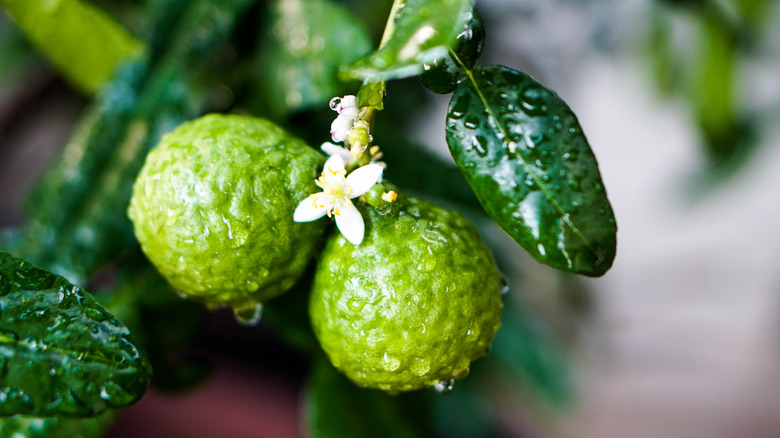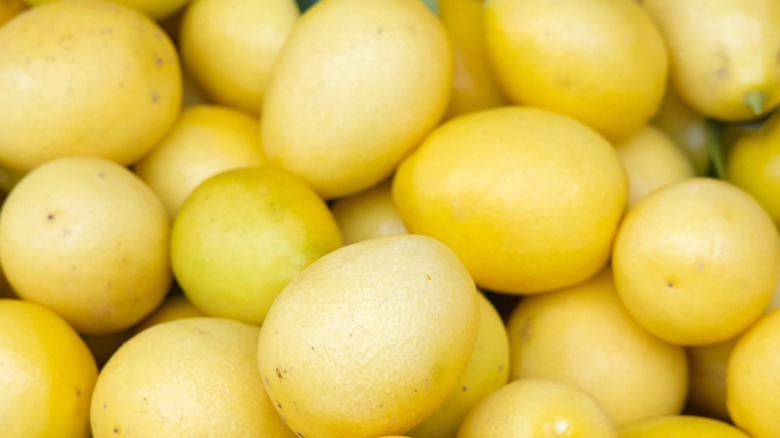What Is A Limequat And What Sets It Apart From A Normal Lime?
When the weather's still playing hard to get with spring and you can practically taste the warmer days, winter citrus is here to give your recipes that sweet and tangy tropical twist they crave. Sure, lemons, limes, and oranges are the go-to gang, but sometimes your taste buds demand a little adventure. Enter the limequat.
So, what exactly is a limequat, and what sets it apart from a normal lime? The flavorful lovechild of a lime and a kumquat, this teardrop-shaped Franken-fruit combines the best of its parent produce into one mouth-puckering package that's perfect for pickling, juicing, baking, or just about any other culinary application that calls for a bit of extra brightness. Most folks outside of the Sunshine State might not be in on this citrusy secret, but limequats are the sweet-tart sensation your taste buds never knew they were missing. Whether you're slicing them into a refreshing summer salad, squeezing them into a tangy cocktail, or simply popping them in your mouth for a burst of natural goodness, limequats are a delightful citrus gem that adds a unique and vibrant twist to your culinary escapades.
We've got the scoop on how to snag, prep, and showcase this unique produce. Who knows? It might just become your new culinary secret weapon, adding a burst of flavor and flair to your kitchen adventures.
What is a limequat?
A limequat, scientifically known as citrus x floridana, is the delicious result of a botanical rendezvous between a key lime and a kumquat. This unique citrus hybrid was born in the U.S. Department of Agriculture's experimental Florida gardens around 1909, under the watchful eye of botanist Walter Swingle. Swingle's goal was to create a heartier lime variety capable of withstanding colder temperatures, a response to the devastating freezes that wreaked havoc on Florida's citrus crops in the mid-1890s.
The marriage of the cold-resistant kumquat and the temperature-sensitive key lime turned out to be a stroke of genius, producing the limequat — a fruit bursting with juicy potential. However, despite its promising origins, limequats haven't made it to the big leagues of industrial-scale production, remaining somewhat of a hidden gem for most consumers.
In their native Florida, limequats have found a niche as a slightly sweeter alternative to key limes in classic pies. Although limequats are cultivated in sub-tropical climates globally, they often serve as ornamental plants rather than culinary ingredients. While this citrus hybrid might not be a household name yet, those who discover its tangy-sweet goodness unlock a unique and flavorful addition to their culinary repertoire.
Limequats vs. limes
When it comes to limequats versus conventional limes, it's like comparing cousins with distinct personalities. The key lime, also known as the West Indian lime, is the epitome of tropical vibes, but it can't quite handle South Florida's occasional winter frost. Limequats, on the other hand, emerge as the hardier, more adaptable offspring, thanks to their key lime and kumquat parentage. This not only boosts their temperature resilience but also addresses food waste concerns since limequats, like kumquats, boast an edible rind — a delightful departure from the traditional lime-peeling routine.
Taking a cue from their kumquat side, limequats flaunt a vibrant color palette ranging from greenish-yellow to almost orange, setting them apart from the earthy green hue of conventional limes. Despite their petite, two-inch stature reminiscent of key limes, limequats could easily be mistaken for lemons due to their oblong, teardrop shape. However, a quick taste test reveals the unmistakable sweet-tart pulp, distinguishing these citrus gems from their super-tart relatives. In the limequat world, it's not just about surviving the weather; it's a flavorful, colorful journey that adds a zesty twist to the citrus family tree.
What does a limequat taste like?
Limequats pack a flavor punch that's both zesty and sweet — a combination that's all but guaranteed to make your tastebuds sing. Picture this: a burst of citrusy brightness that starts with a tangy kick reminiscent of a lime, but then mellows into a subtly sweet, floral note akin to a kumquat. It's like nature's little citrus surprise, offering the best of both worlds.
The initial zestiness wakes up your palate with a bright, acidic taste sensation. As you bite into the thin, edible peel, there's an explosion of citrus oils that release an aromatic fragrance, enhancing the overall experience. The sweetness that follows isn't overpowering — it's more of a gentle, honeyed kiss that rounds out the flavor profile perfectly.
On the tartness scale, the limequat leans more towards the bright, acidic notes of lime rather than the sharp sourness of a lemon. While the citrusy segments take on key lime-like traits, the rind is purely kumquat — thin, tender, sweet, and snackable. When combined in one mouthful, the result is an aromatic sweet-and-sour taste sensation that appeals as much to sour candy lovers as to citrus enthusiasts. While you can certainly snack on limequats straight off the tree (after a good wash, of course), the acidic nature of the limequat makes it more conducive to cocktails, marinades, or cooked applications like jams.
How to cook with limequats
Limequats are your versatile, flavor-packed companions in the kitchen, turning ordinary dishes into extraordinary delights. Whether in salads, desserts, or refreshing drinks, these little wonders are here to elevate your culinary game to mouthwatering new heights. And the best part? You can use every part of the fruit to maximize that flavor potential.
The one-two punch of tartness and acid may be too bracing for some folks to savor whole, but those who like a little pucker can try slicing a few limequats into thin rounds and tossing them into a refreshing salad. The combination of zesty tang and sweet notes from the winter citrus in this recipe will add a burst of welcome sunshine to your greens.
Thanks to its bright, tart flavor, limequat juice makes a palate-pleasing addition to any recipe that calls for lime or key lime juice. One easy hack for maximizing juice output? Zap fresh limequats in the microwave for 10 seconds at a time until just warm. Reap the tasty rewards in a limequat twist on simple fresh limeade or as the acidic element in a marinade or vinaigrette.
While the juice provides plenty of mouth-puckering flavor, the zest is where the party's at. As with any other citrus, the rind contains aromatic oils that add an extra dose of flavor to everything from simple citrus cakes to fruit-infused caramel. You can even candy the zest for a sweet and satisfying treat used to top salads or for snacking.
Where to buy limequats
To say that limequats are an elusive fruit is a bit of an understatement. The sub-tropical fruit is not widely available even in its home state of Florida, making the sourcing of limequats a bit of a treasure hunt. This is why finding a crop of this winter citrus is a bit like striking gold.
First off, check out your local farmers' markets or specialty grocery stores. These little yellow gems might not always be front and center, so keep an eye out in the citrus section or ask a friendly employee who probably knows all the nooks and crannies of the store. If your neighborhood grocery spot is a bit traditional, don't despair. Online options are a game-changer — explore websites that specialize in unique and exotic fruits. Some online grocers even let you set up subscriptions, ensuring a steady supply of these citrus wonders at your doorstep for an extra dose of convenience.
When you're in the store or browsing online, look for limequats that are firm, vibrant, and have glossy skin. Avoid any that look shriveled or overly soft; you want those babies bursting with juice and flavor. Remember, size doesn't matter here — it's the quality that counts. There are a few online retailers that sell and ship limequats nationwide.
Nutritional information about limequats
Like its citrusy cousins, limequats pack a nutrient-rich punch that will leave you feeling refreshed. First off, they're vitamin C powerhouses — you know, the stuff that keeps your immune system in check. A small serving of limequats can give you a decent chunk of your daily vitamin C fix, helping you fend off those pesky colds.
But that's not all — these little yellow wonders also bring fiber to the table, promoting a happy and healthy digestive system. It's like a mini cleanse for your gut, courtesy of nature's zesty creation. Limequats are also loaded with antioxidants, helping to combat those free radicals like superheroes fighting off villains. Antioxidants are a sort of secret weapon against aging and all sorts of degenerative diseases. Don't overlook the minerals either: Limequats serve up potassium, essential for maintaining a balanced water and electrolyte level in your body.
So, the next time you pop a juicy limequat, know that you're not just indulging in a burst of flavor, you're treating your body to a nutrient-packed party. Immune support, digestive happiness, antioxidant action — limequats just might be the nutritional sidekick you never knew you needed.
Varieties of limequats
Florida-born and bred, limequats come in three distinct varieties, each named for the city in which they were created. Each brings something slightly different to the flavor party and is worth experimenting with — if you can find them all. Whether you're into bold and tangy or sweet and subtle, there's a limequat variety waiting to dazzle your taste buds.
First up, we've got the classic Eustis limequat. The most common variety of the elusive fruit, the Eustis is the original limequat, packing that perfect balance of tang and sweetness. It's like a dependable friend who always knows how to liven up the party. If you're into a sweeter vibe, the Lakeland limequat is your go-to. This varietal boasts a milder tang and a hint of honeyed sweetness that makes it a slightly less acidic alternative to the traditional Eustis and the perfect specimen to use in dessert applications.
An even lesser-known variety, the Tavares limequat is a bit of a citrus step-child thanks to its parentage — it's a cross between a key lime and an oval kumquat, rather than the round kumquat like the Eustis and Lakeland varietals. Tavares limequats feature a unique combination of tartness and floral notes with an elongated shape and yellow-orange rind that make it ideal for use in cocktails.
How to store limequats
It's time to talk limequat TLC because we want those zesty gems to stay fresh and fabulous as long as possible. The first rule of thumb: Keep them cool, like a citrus spa day. Storing them at room temperature is fine if you plan to use them up quickly, but if you've stocked up on the elusive produce and want to slow down the ripening party, just pop them in the fridge.
When it comes to humidity, remember that limequats are a sub-tropical fruit. All that means is that they dig a bit of moisture. If you're storing them on the countertop, a bowl or basket is their happy place. In the fridge, a perforated plastic bag will do the trick. Think of it as their cozy citrus cocoon. The idea is to keep them away from ethylene-producing fruits like apples and bananas — they don't play nice when it comes to storage. Ethylene can speed up the ripening process, and we want to savor those limequats at their optimal freshness.
If you've got more limequats than you know what to do with, go ahead and freeze them. Slice or juice them, pop them in an airtight container or a freezer bag, and voila, limequat goodness ready for a future flavor fiesta. Remember, limequats are like citrus royalty: Treat them right, and they'll stay juicy and flavorful.
How to grow limequats
Unless you live in Florida or California, sourcing fresh limequats can be a challenge. Luckily if you have a green thumb, you can pretty easily procure a limequat tree to grow the tangy treasures yourself. These little guys are hardy, so they'll likely survive even if you've accidentally killed a few succulents in the past — no judgment here. Next, choose a sunny spot for your limequats to call home. When planting, give your limequats some space to spread and remember that well-draining soil is their jam, so add some compost for good measure.
When it comes to care, the key to healthy limequats is consistent watering. The winter citrus likes its soil moist, but not swimming-pool level. Feed your brood with a citrus-friendly fertilizer and be sure to prune those branches a bit to keep the tree bushy and manageable.
One last tip: If you don't live in the tropics, consider planting your limequat in a pot. This way, you can bring the tree indoors during the colder months. Even though the winter citrus was bred to withstand frost, it can only do so for short periods of time.









